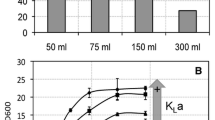Summary
Experiments in batch-fermenters have demonstrated that the 11β- and 19-hydroxylation of Reichstein's Substance S by Pellicularia filamentosa ceases in the absence of glucose. The effects of glucose consumption rate and growth rate on hydroxylation have been investigated using chemostat cultures. With glucose-limited cultures, increased hydroxylation rates were observed with increased glucose consumption rates. With nitrogen-limited cultures, however, some form of glucose-repression exists. The maximum rate of hydroxylation occurred at a glucose consumption rate at which the culture was just nitrogen-limited. The growth rate had no major importance.
Similar content being viewed by others
References
Breskvar K, Hudnik-Plevnik T (1978) Inducibility of progesterone hydroxylating enzymes in Rhizopus nigricans. J Steroid Biochem 9:131–134
Clark TA (1982) The 19-hydroxylation of cortexolone by the fungus Pellicularia filamentosa. Ph.D. thesis. Massey University, New Zealand
Clark TA, Chong R, Maddox IS (1982) The effect of dissolved oxygen tension on 11β- and 19-hydroxylation of Reichstein's Substance S by Pellicularia filamentosa. Eur J Appl Microbiol Biotechnol 14:131–136
Hanisch WH, Dunnill P, Lilly MD (1980) Optimisation of the production of progesterone 11α-hydroxylase by Rhizopus nigricans. Biotechnol Bioeng 22:555–570
Hanisch WH, Dunnill P (1980) Regeneration of the 11α-hydroxylase of Rhizopus nigricans by the use of periodate. Biotech Letts 2:123–126
Lin YY, Smith LL (1970) Microbial hydroxylation. VII. Kinetic studies on the hydroxylation of 19-norsteroids by Curvularia lunata. Biochim Biophys Acta 218:515–525
Maddox IS, Dunnill P, Lilly MD (1981) Use of immobilized cells of Rhizopus nigricans for the 11α-hydroxylation of progesterone. Biotechnol Bioeng 23:345–354
Marscheck WJ (1971) Current trends in the microbiological transformation of steroids. In: Hockenhull DJD (ed) Progress in Industrial Microbiology 10:49–103
Pirt SJ (1975) Principles of microbe and cell cultivation. Blackwell Scientific Publications, Oxford
Sedlaczek L, Jaworski A, Sasiak A, Zajaczkowska E (1979) The oxidation-reduction state of the nicotinamide nucleotides and the steroid 11α-hydroxylase activity in Monosporium olivaceum ATCC 36300. Acta Microbiol Polonica 28:111–121
Solomons GL (1975) Submerged culture production of mycelial biomass. In: Smith JE, Berry DR (eds) The filamentous fungi, vol 1. Industrial mycology. Arnold, London
Vezina C, Seghal SN, Singh K (1968) Transformation of organic compounds by fungal spores. Adv Appl Microbiol 10:221–268
Wettstein A (1955) Conversion of steroids by micro-organisms. Experientia 11:465–479
Zuidweg MHJ (1968) Hydroxylation of Reichstein's Substance S with cell free preparations from Curvularia lunata. Biochim Biophys Acta 152:144–158
Author information
Authors and Affiliations
Rights and permissions
About this article
Cite this article
Clark, T.A., Maddox, I.S. & Chong, R. The effect of glucose on 11β- and 19-hydroxylation of reichstein's substance S by Pellicularia filamentosa . European J. Appl. Microbiol. Biotechnol. 17, 211–215 (1983). https://doi.org/10.1007/BF00510417
Received:
Issue Date:
DOI: https://doi.org/10.1007/BF00510417




